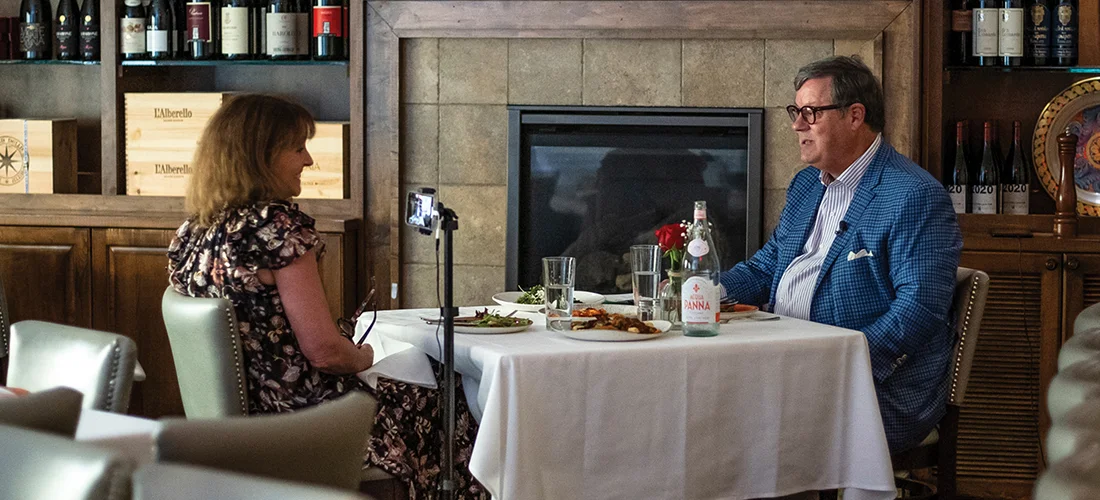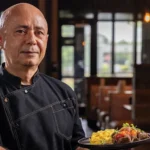SouthPark Sit-down: Chris Thomas
June 28, 2024

SouthPark’s homegrown visionary
by Natalie Dick | photographs by Richard Israel
Few people know SouthPark as well as Chris Thomas. He’s a living encyclopedia of the community he’s called home his entire life. The Charlotte native grew up in the Montclaire neighborhood not far from SouthPark Mall, where he and his childhood buddies rode their Spyder bicycles on long summer days.
“It was such a carefree time,” recalls Thomas, retail partner at developer Childress Klein. “We were turned out by our parents in the morning, and if you came home by supper, you were OK. That allowed — for better or worse — a lot of adventures that my friends and I had growing up. We all had bikes, and we could move around with relative ease — traffic in those days was nothing like it is today.”
I’ve been looking forward to catching up with Thomas for weeks. We meet at Toscana, Augusto Conte’s beloved Italian spot at Specialty Shops SouthPark. It’s a favorite lunch and dinner destination for Thomas because of the food, ambience and the “top-shelf experience Augusto and his team deliver,” he says.
He orders the Mare, a seafood linguine, and I select the Ravioli. We’ve blocked a few hours in the private dining room. Already, I know that’s not nearly enough time to cover everything I want to ask him. It’s simply so much fun tapping into his wealth of knowledge — and insider’s scoop — of SouthPark.
GAINING A FOOTHOLD
The SouthPark of Thomas’ youth looked very different from the one he’s spent much of his professional career working to shape. Sharon Corners’ primary retail tenant was a hardware store with a small post office in the back. Park Road Park wasn’t built until he was 13. And the area’s most iconic structure, aside from the mall’s globe-like dome, was the now-demolished Sharon United Methodist Church, with its towering “ski-slope” steeple. Apex SouthPark stands there now, a high-end mixed-use development of retail, apartments, a Hyatt Centric hotel and the rebranded SouthPark Church — a project Thomas helped bring to life.
“At the time, SouthPark felt like an extension of the neighborhoods around it,” he explains. “My aunt worked at Eastern Air Lines in the reservation center. That and Celanese (where Piedmont Town Center now stands) were the two major employers in the area. There was plenty of open land. The walkable society that we all now want to build — those are ideas that have been with me for as long as I can remember.”
It isn’t a coincidence that Thomas has dedicated his life to improving and protecting the community he cherishes. He is soft-spoken yet deliberate when discussing his 40-year career in retail development and marketing: the first 14 years as a manager and vice president of real estate for Belk, and the last 26 with Childress Klein.



Top right: Mista salad with blackened chicken. Bottom right: Ricotta-filled ravioli with tomato basil sauce and parmigiano
“I interviewed with Belk on the campus of UNC Chapel Hill during my senior year. I knew very little about the organization other than it was a prestigious company. I felt very fortunate to be considered for the position, and it was a chance to come home. When Belk made me the offer, I had no idea the degree to which that would propel me in the retail-real estate direction. It was such a privilege to work for John and Tom Belk, who, with their sister Sarah and brother Ike, made a lasting impact on this city and beyond.”
That was the mid-’80s. Charlotte was evolving, and change was afoot for the mall, which opened in 1970, and, subsequently, the SouthPark community.
“I had the chance to work with some of the people who helped create SouthPark Mall,” Thomas continues. “It was awe-inspiring because it helped me to understand what a commitment the Belk and Ivey families had made to moving retail from the center city into the suburbs. They had the vision to work with the Harris and Bissell families, as well as others, to create something very special.”
What they were creating was much more than just a mall. It exemplified the “Charlotte story” — one of business leaders teaming up to mold the community’s future. As the ’90s rolled around, Thomas found himself entrenched in deals to help bring those visions to life. He calls it the “SouthPark 2.0” period, when Ivey’s was sold to Dillard’s and Morrocroft was developed. During that time, Thomas and his wife, Jane, bought their first house in Beverly Woods East. Within walking distance of the mall, they raised their two children in the home and still live there today.
“We thought we were crazy at the time buying a house we didn’t think we could afford for $159,000,” he laughs. “Those lifetime relationships and the feeling of community were values we wanted to replicate for our family. A lot of what we do today is dedicated to creating and maintaining that quality of life for the people we care about.”
INVESTING IN COMMUNITY
Giving back and paying it forward have always been a cornerstone of Thomas’ personal life. It is fortuitous that his calling to volunteer in the community has aligned so perfectly with his professional goals. He’s served on the board and is a trustee at YMCA of Greater Charlotte, where he led the capital campaign to build the Harris YMCA Cato Education Center, a classroom hub with an outdoor pavilion for public gatherings. As a member of the United Family Services (now Safe Alliance) building committee, he helped oversee the development of the Dickson Domestic Violence Shelter. Thomas also donates his time to Trees Charlotte and the Catawba Lands Conservancy to help protect the city’s natural beauty.
More recently, he joined the board of The Sharon at SouthPark (formerly Sharon Towers), where he worked on a new land-use plan for the senior-living campus. The first new building, upscale independent-living apartments called The Deerwood, opened in 2023. The half-acre Anne O. Moffat Park was created to encourage connectivity between the retirement community and surrounding neighborhoods. “I want to see multigenerational living. We need to take advantage of the power that exists when old people and young people spend time together,” Thomas says.
During the pandemic, a frustrated Thomas taught neighborhood kids civics lessons on his back porch. “I would see all of them hanging out together because they couldn’t go to school. So, I decided to teach a civics class every Monday night on our patio. I spent the equivalent of a semester teaching eighth to 12th graders just for fun. [Former Charlotte Observer publisher] Rolfe Neill and I had talked about launching a platform to continue it before he got sick.” (Neill passed away in July 2023.)
The post-Covid world brought about new challenges, as Charlotte’s population continued to explode with people moving here from across the country. “That was certainly an engine for some of the diversity we now see,” Thomas says. He points to geography, the airport, and the longtime benevolence of business and community leaders for growing the Queen City’s appeal beyond its borders. “We see young people choosing to come to Charlotte, sometimes even without a job offer. Our challenge is what to do with that.”


Linguini with lobster, scallops, calamari, mussels, clams, shrimp and peperoncino
SOUTHPARK 3.0
Enter SouthPark 3.0. After years of studying and discussing the creation of a SouthPark Municipal Service District, SouthPark Community Partners (SCP) launched in 2022. The public-private nonprofit is designed to promote economic development and help build SouthPark’s identity. Thomas, who is board chair, co-led the effort to establish the group.
“Part of our vision for SouthPark is to be a place with economic and cultural diversity, because that’s how we’ll be the strongest and best going forward,” he says. “We need neighborhoods not just for the CEOs and decision-makers, but also for the middle managers and others. If we create activity on the streetscape, if we bring buildings up to the sidewalks like at Apex SouthPark to create an urban feel, we also increase opportunities for people of all ages and backgrounds to interact with each other.”
In April, SCP unveiled a $250 million SouthPark Forward 2035 Vision Plan that includes more than 60 projects designed around three themes: places, connections and mobility.
“What we’re trying to create is the marketplace,” Thomas says. “The Romans called it the agora — a place where people gather. That’s really what we’re charged to create more of here. We want to see mobility, connectivity, pedestrian-scaled development. There’s some of it in place, but we need more gathering places for our families, more impactful open spaces and entertainment.”
One of the first new initiatives is a shuttle service, which is expected to debut soon. “SouthPark will be a park-once type of environment. We have plenty of parking; it’s a matter of using it more efficiently.”
With nearly 30,000 people currently working in the SouthPark MSD and new residential construction on the rise, tackling traffic issues will be challenging. Thomas isn’t deterred — he’s excited.
“We’re just now seeing the opportunity for new people and companies to be involved at the development level of SouthPark, because it was so closely held for so many years. This is lending itself to a newfound progressiveness. Developers feel a real responsibility to honor the past while advancing the vision for the future.”
And as always, Thomas plans to be there, leading the charge.
“What matters in life is to use our God-given gifts to do what we have a passion to do, and I’m doing it and I feel incredibly blessed. The Japanese have a phrase, ikigai, which means your reason for living. I’ve found mine, and I plan to continue doing it for many years to come.” SP
TAKE FIVE
Comments have been edited for length.
What is sometimes misunderstood about SouthPark?
We have a nice diversity of housing in SouthPark at different price points, and our neighborhoods have great character. I think it’s important this is maintained to appeal to families of all income levels.
Who are your mentors?
I had great teachers at CMS growing up. Some friends and I started a foundation at Olympic High School (his alma mater) about 10 years ago to support the teachers and students. We’ve raised close to a million dollars. Dave Hartzell, who taught my first real-estate class at Chapel Hill, is still a dear friend today. Also, some friends from my Belk days who, when I was 21 years old and green as grass, took me to lunch and under their wings. I owe those guys — Paul Wyche, Luther Moore, Terry Scott and Bill Wilson — so much.
How do you unwind?
Driving on the open road is my therapy. I love to take a drive in one of my convertibles. I have a 1990 Saab with 42,000 miles and a newer BMW. I’m also a voracious reader, primarily nonfiction.
Old school or new school?
I try to stay abreast of trends, but when it comes to my daily routine, I am old school. I still have three newspapers delivered to my home each morning: The Wall Street Journal, The New York Times and The Charlotte Observer.
What keeps you up at night?
I’m particularly concerned about some of the consequences of Charlotte’s Unified Development Ordinance, including the possibility that triplexes could be built in the middle of our existing neighborhoods. Allowing that in certain cases could harm the integrity of these neighborhoods.
